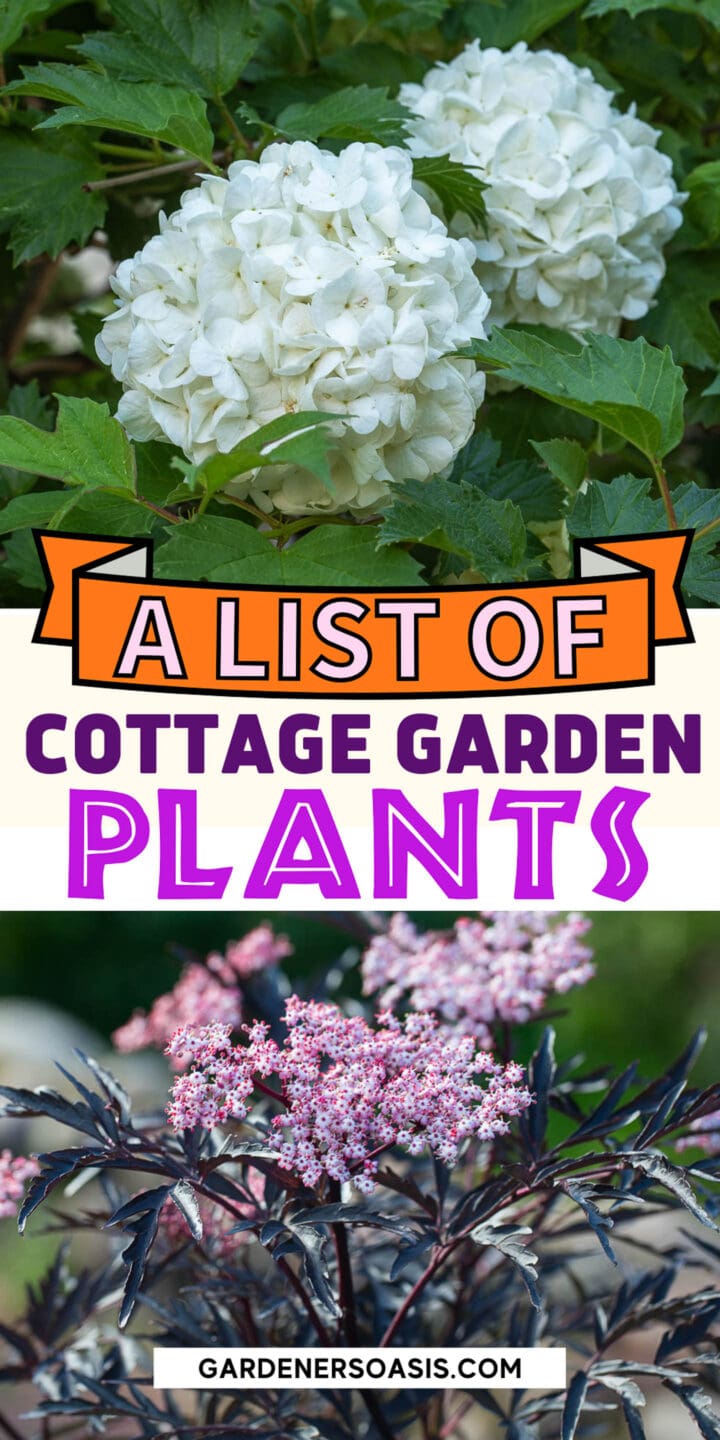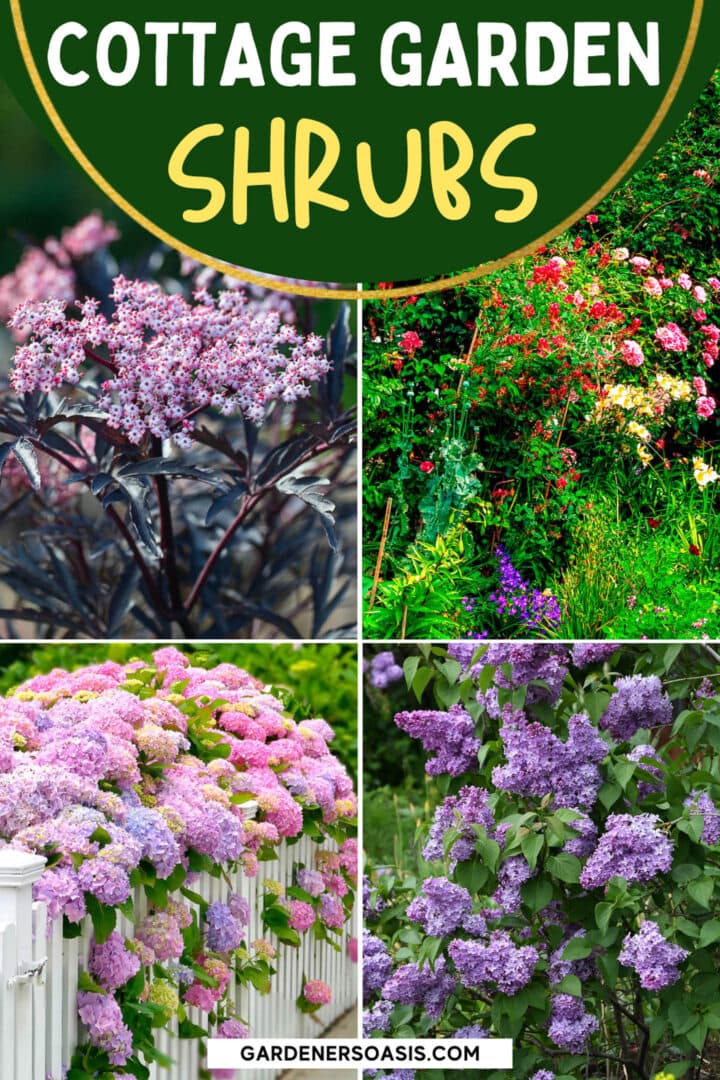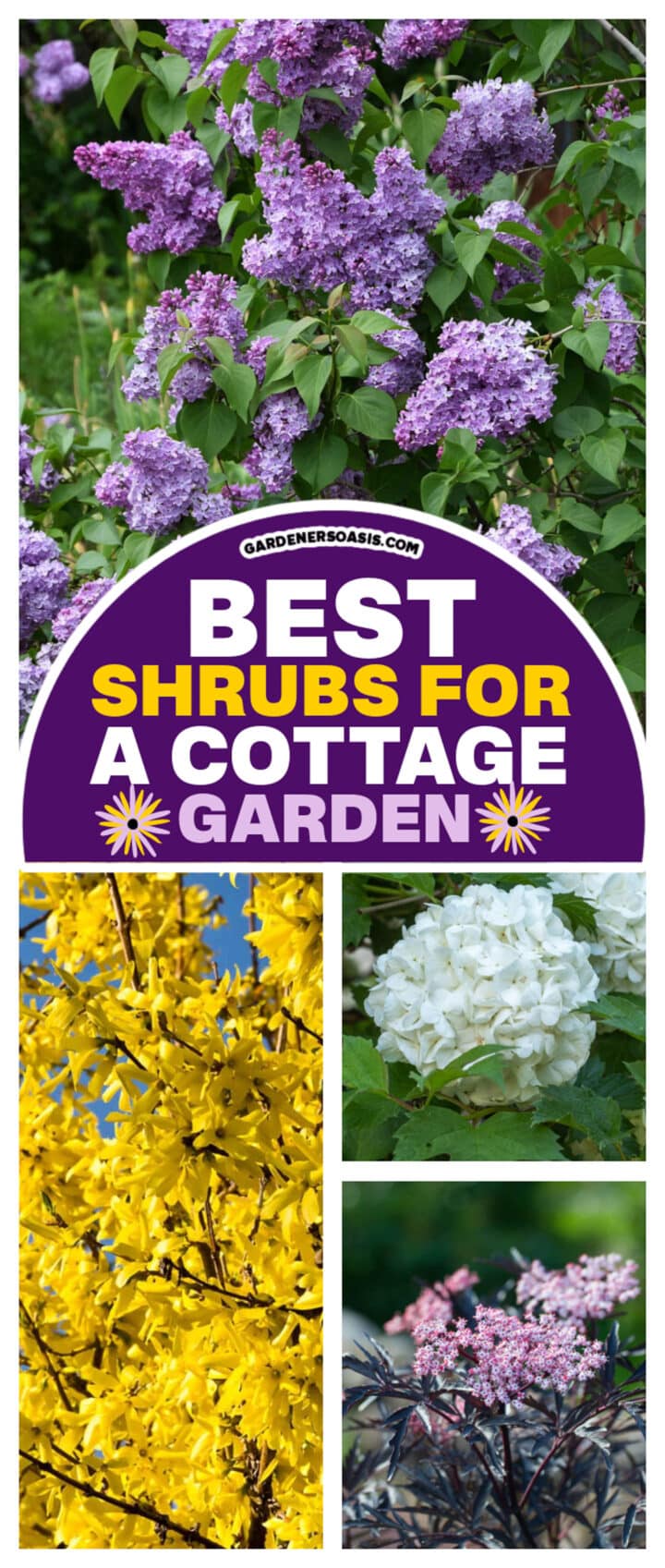Best Shrubs For A Cottage Garden
If you’re looking to create an English cottage garden in your yard, one of the first plants you’ll need are bushes. Not only do they provide valuable privacy and shade, but they also add structure to your landscape. Here are a few varieties that offer a great combination of beautiful flowers, easy upkeep, and manageable size, making them the best shrubs for a cottage garden.

Cottage gardens are a popular style of garden, loved for their informal and relaxed look.
And while perennials are the star of the show, they also need shrubs to provide some structure.
Many traditional cottage gardens use evergreen shrubs (such as yews and boxwoods to create a backdrop for all of the colorful flowers.
But you can also incorporate blooming bushes as part of the garden design.
To be a good cottage garden plant, these shrubs must offer tons of pretty flowers, be easy to care for, and not grow so big that they take over.
This list of cottage garden shrubs provides tips for growing many of the traditional options as well as suggestions for newer varieties that may work better in an urban-sized yard.
1 | Shrub roses
This post may contain affiliate links. We make a small commission if you buy the products from these links (at no extra cost to you). As an Amazon Associate, I earn from qualifying purchases. But we only recommend products we would use ourselves. For more information, click here to see our disclosures.
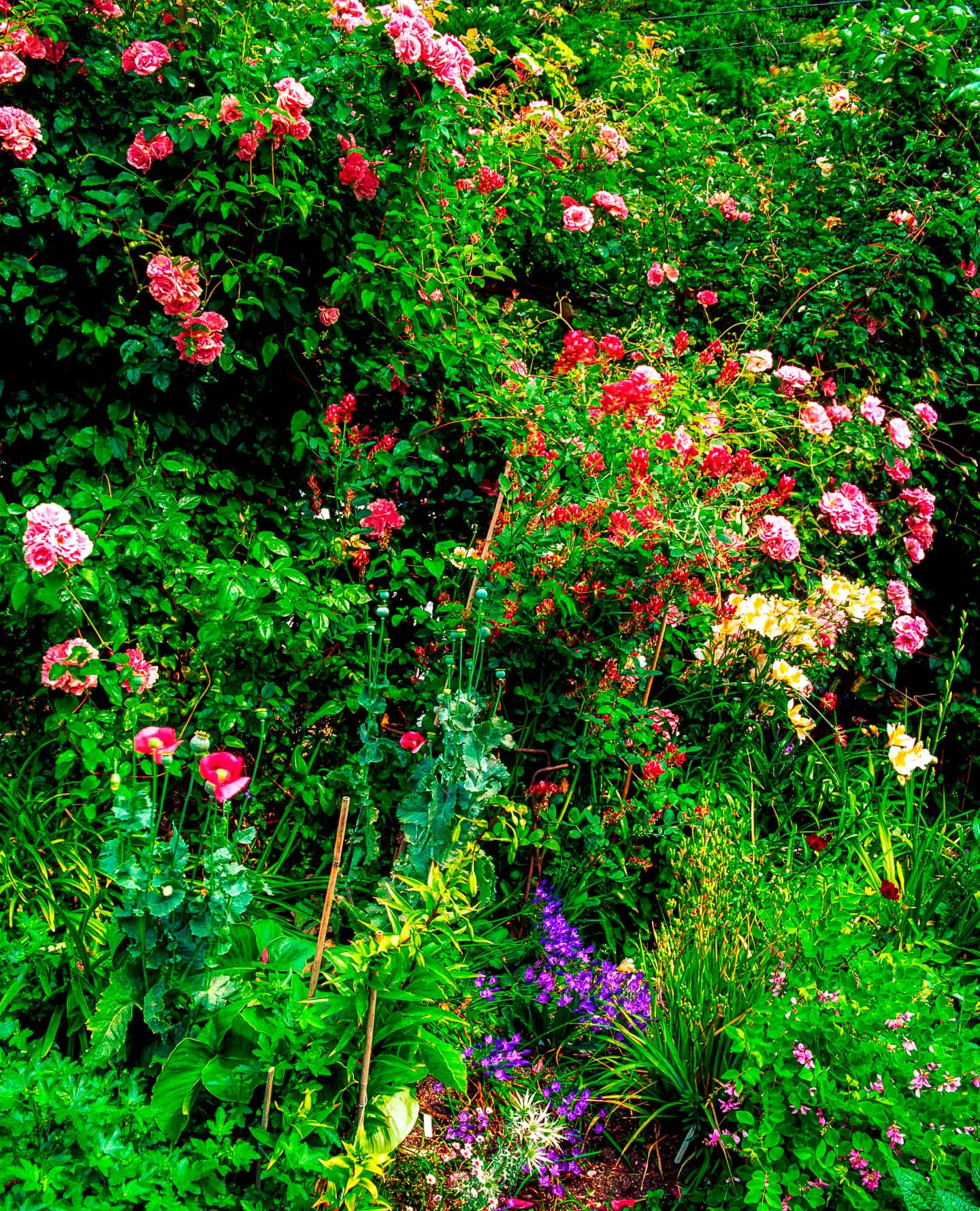
Zones: 3 to 10
Exposure: Full sun
Height: 2′ to 5′, can be taller depending on the variety
Bloom time: Late spring through summer and into fall
Bloom color: Purple, orange, yellow, pink, red, white
Roses are the most important bushes to have in your cottage garden.
Look for old fashioned species that are hardy, disease resistant, come in pastel colors and are aromatic.
The modern English roses, like those bred by David Austen, have these features and are also either long blooming or repeat bloomers.
The Canadian bred Explorer and Parkland Series were developed to withstand winter temperatures as cold as -40 degrees F. and are low maintenance, disease resistant, and summer flowering.
Be sure to read the labels to make sure they will grow in your zone.
A few of the most fragrant shrub roses are ‘Banshi’ (double pink), ‘Abraham Darby’ (double pink/apricot), ‘Fair Bianca’ (white), ‘Golden Wings’ (yellow), ‘Louise Odier’ (pink), ‘Morden Sunrise’ (yellow/orange), ‘Nuits de Young’ (purple), ‘John Cabot’ (fuchsia).
Tips for growing roses
- Roses need to be planted in well-drained sites, as they do not like wet feet.
- Once they are established they rarely need extra watering due to their deep root system.
- Prune shrub roses to remove any dead or diseased branches and any branches that are touching.
- Fertilize with composted manure in the spring and with liquid fertilizer in July.
- Deadhead until late August to encourage new blooms, then let the hips form.
- The edible rose hips can be harvested in the fall and made into jam or tea. Hips are very high in Vitamin C.
- To make sure that they grow well, only purchase your roses from a reputable nursery. I prefer those plants that are grown on their our root stock.
Find out more about growing roses HERE.
2 | Lilacs
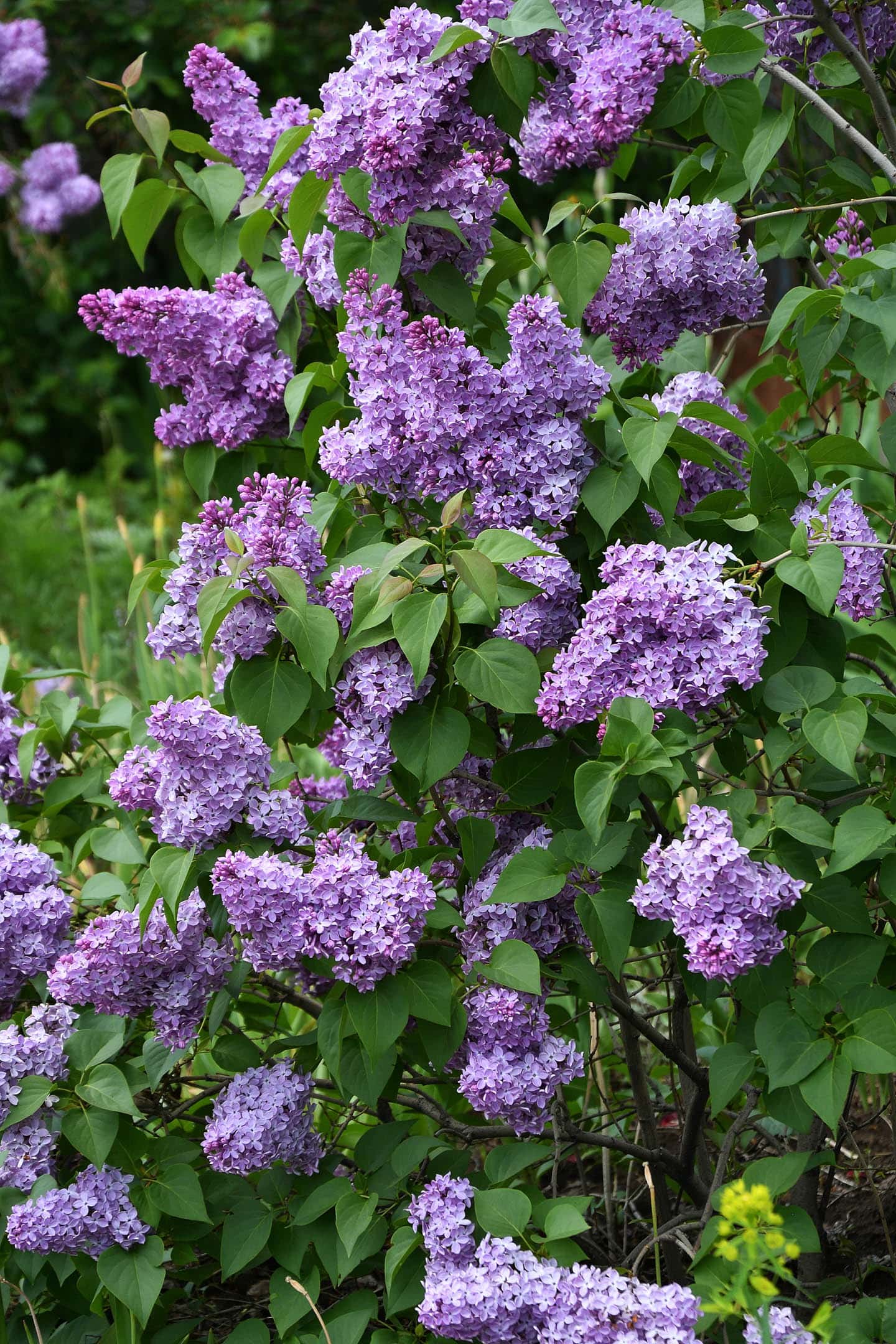
Zones: 3 to 8 (depending on the variety)
Exposure: Full sun
Height: 2′ to 12′ (depending on the variety)
Bloom time: Spring for most, except for ‘Bloomerang’® which reblooms all season
Bloom color: Purple
Lilacs are very easy care, low maintenance, sweetly scented shrubs that pack a wallop in the spring cottage garden.
The common lilac, syringa vulgaris, and the French lilac grow too big for a small urban cottage garden.
Instead, choose the Korean variety ‘Baby Miss Kim’ or the reblooming ‘Bloomerang.’®
Or try ‘Scentara Pura’ for its amazing fragrance, true purple color and disease resistance. (No powdery mildew!) It performs better in warm climates than any other lilac.
Tips for growing lilacs
- Lilacs need well-drained, slightly alkaline soil.
- They do not do well in wet conditions, and do not need extra watering unless there is a drought.
- Ideally, the lilac bush is best planted in the fall in soil that is not amended.
- If desired, fertilize established bushes in early spring, after the ground thaws.
- Prune for good air circulation immediately after blooming.
- Lilacs attract butterflies and are deer resistant.
- Don’t forget to cut some branches to enjoy indoors.
Find out more about growing lilacs HERE.
3 | Forsythia ‘Show Off’ (Forsythia x intermedia)
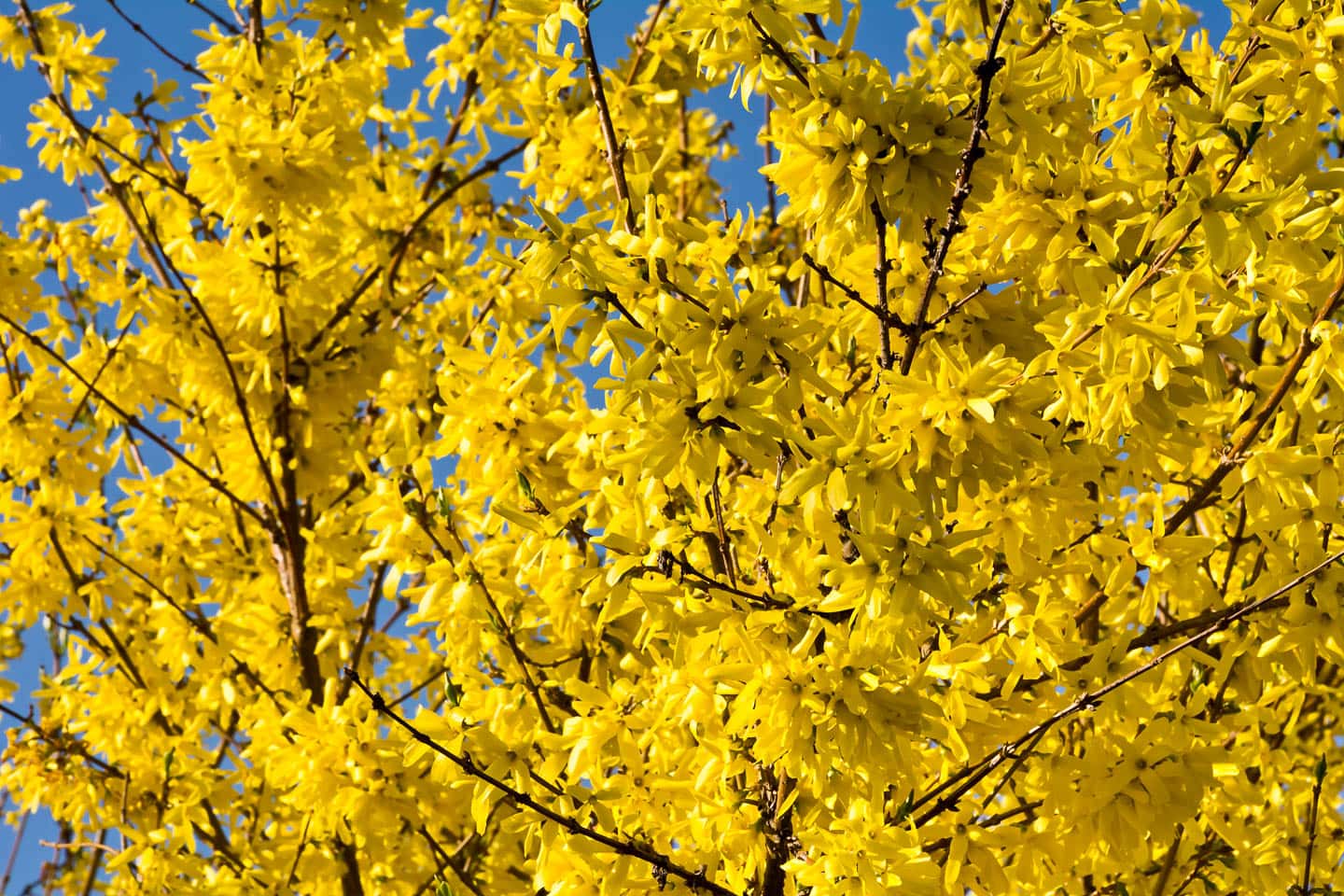
Zones: 5 to 8
Exposure: Part sun to full sun
Height: 5′ to 6′
Bloom time: Early spring
Bloom color: Yellow
Forsythia is another common cottage garden shrub. It is one of the earliest to bloom in the spring.
When choosing a specimen forsythia, the new smaller varieties like Proven Winner’s forsythia ‘show off’ are the way to go.
It never needs pruning, deer don’t like it, the yellow spring flowers are vibrant, and it has improved flower display.
Tips for growing forsythia
- Forsythia prefers loose, neutral soil and needs medium moisture.
- Fertilize in the spring with a slow-release, tree and shrub fertilizer.
- It withstands city pollution well.
- Branches can be forced into bloom indoors in early spring or the flowering branches can be cut for a bouquet.
4 | Illuminati Arch Mockorange (Philadelphus coronavius)
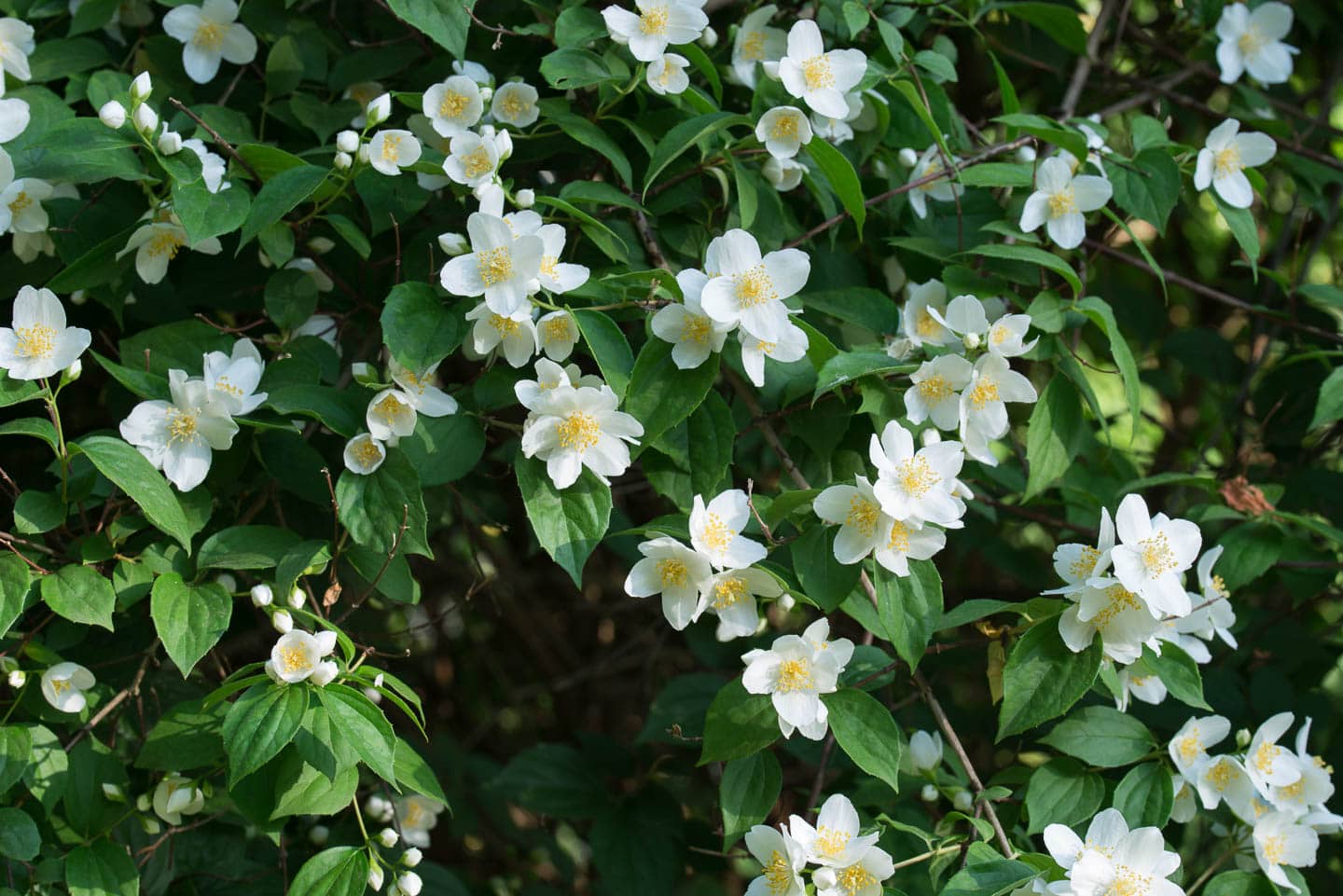
Zones: 4 to 7
Exposure: Full sun to part sun
Height: 4′
Bloom time: Early summer
Bloom color: White
Mockorange is an easy care deciduous shrub that is mainly grown for its very fragrant white flowers in early summer.
Look for Illuminati Arch mockorange by Proven Winners for its compact size and improved, tidy appearance.
Tips for growing mock orange
- Plant in humus-rich acidic to neutral soil that drains well.
- It does not like soggy conditions and will not need watering after it is established unless a drought occurs.
- This variety requires very little pruning.
- If you desire, prune to an outside facing node immediately after flowering.
- Fertilize in the spring with a rose fertilizer.
- This shrub is disease and pest free, and disease resistant.
- The blooming stems make good cut flowers.
5 | Hydrangea macryophylla
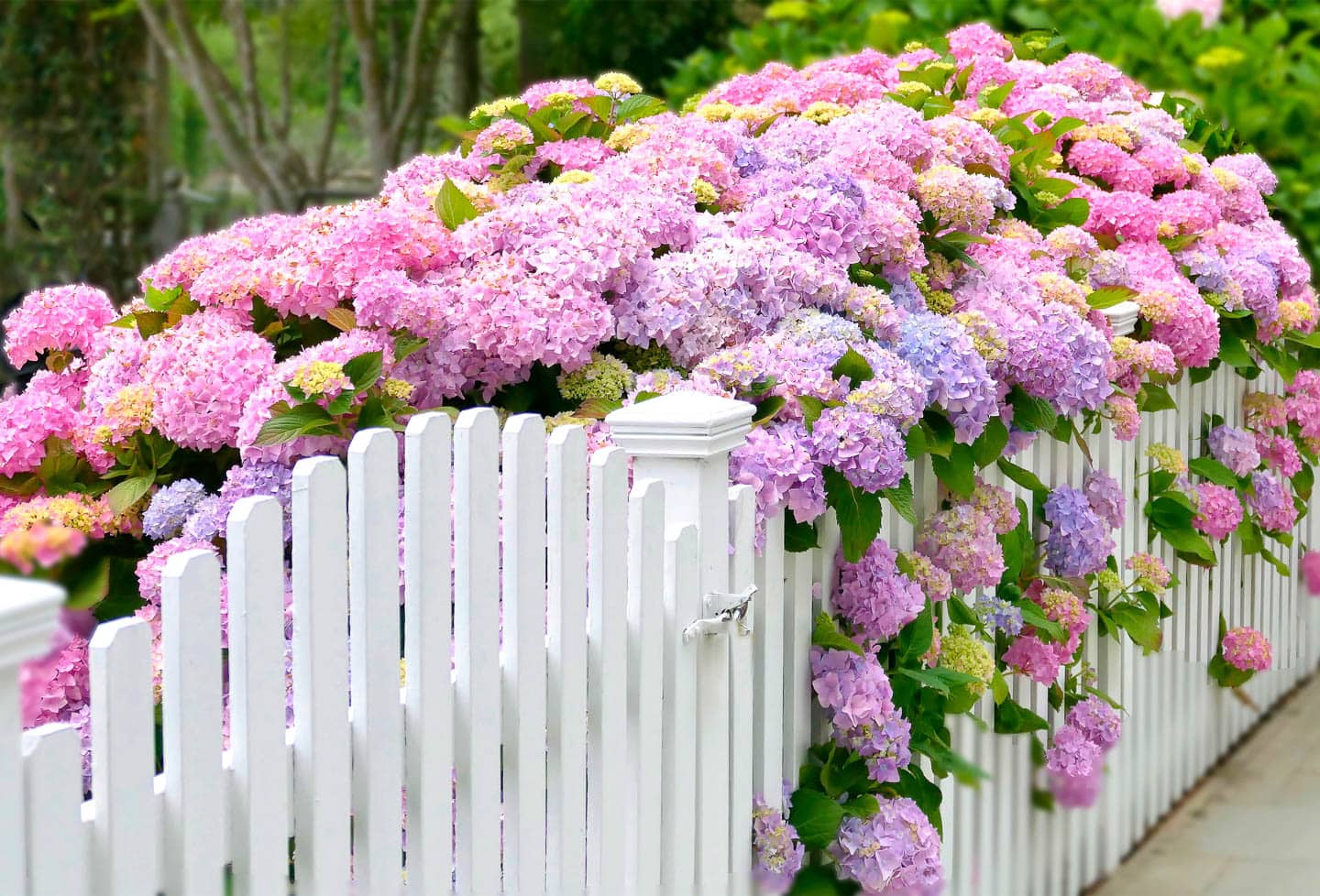
Zone: 5 to 11
Exposure: Part shade to full shade
Height: 3′ to 6′
Bloom time: All summer through fall
Bloom color: White, blue or pink depending on soil pH
Hydrangea macrophylla is an easy care plant that blooms all summer long in the cottage garden.
Hydrangea macrophylla (also called bigleaf, mophead, lacecap, and French hydrangea) are deciduous bushes that bear large blooms the color of which depend on the soil pH.
Strongly acidic soils result in blue blooms and neutral to alkaline soils produce pink ones.
Tips for growing Hydrange macrophylla
- These Hydrangeas need moist but well-drained soil.
- A good layer of mulch covering the roots is also helpful to retain moisture, prevent soil temperature variations, and provide winter protection.
- After blooming, prune back to an outward facing bud.
- Remove dead and weak branches in the spring. Otherwise, don’t prune or you’ll cut off the buds and won’t get any blooms.
6 | Hydrangea paniculata
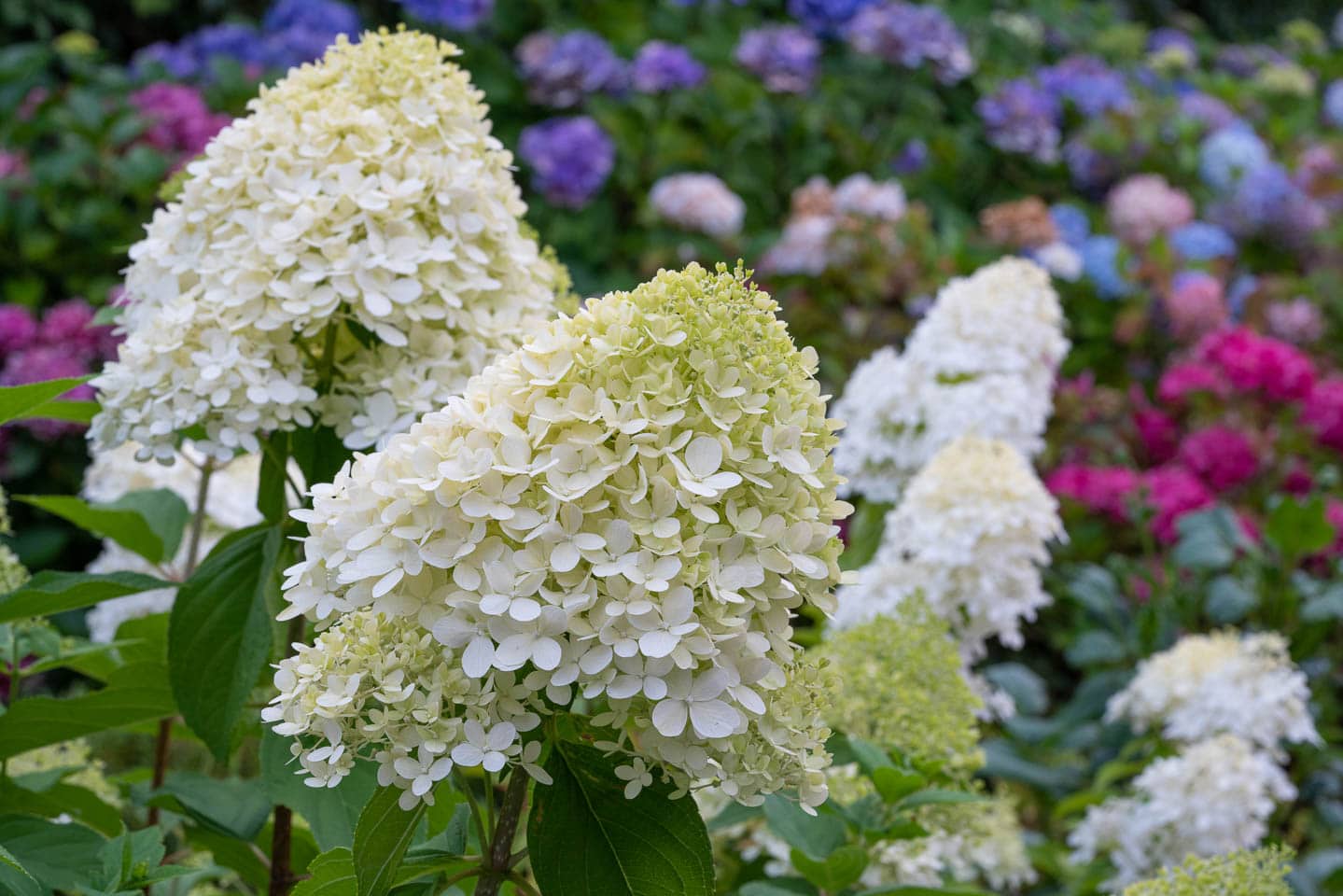
Zone: 4 to 8
Exposure: Full sun to partial sun
Height: 6′ to 10′
Bloom time: Mid-summer to fall
Bloom color: White turning to pink
A totally different type of Hydrangea, Hydrangea paniculata grow in the sun, are tough and very cold hardy.
They are more drought tolerant than the mopheads and are not affected by late frosts because they bloom on new wood.
The large blooms start out white and gradually turn from pink to beige in the late fall. Leaving the dried blooms on the shrub will provide winter interest.
In the fall, the leaves turn red.
They are most commonly seen as standards in the cottage garden so that they will not become too tall.
Tips for growing Hydrangea paniculata
- Plant in medium moist, humus rich soil in any soil type.
- Prune back heavily in the early spring to keep the bush size in check.
- The flowers make attractive bouquets either fresh cut or dried.
7 | Viburnum
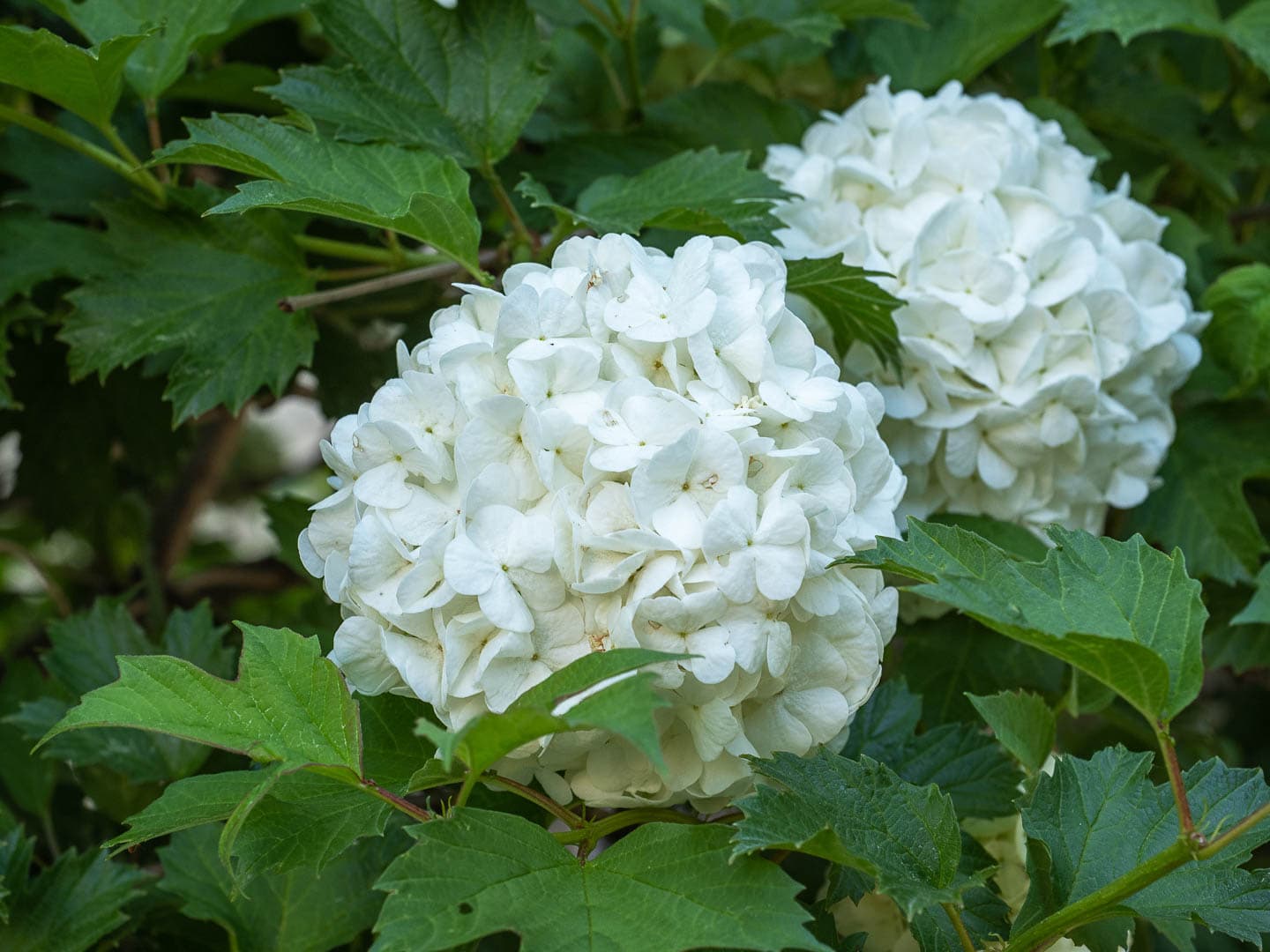
Zone: 4 to 8
Height: 6′ to 10′ (depending on the variety)
Exposure: Sun to part shade
Bloom time: Spring
Bloom color: White
Look for viburnum varieties that are small and fragrant like Burkwood Viburnum (Viburnum x burkwoodii), and Korean Spice Viburnum (Viburnum carlesii).
Burkwood Viburnum is a deciduous shrub with dark pink buds that open to large white, very fragrant flower balls. In summer it gets red berries that turn black in the fall.
‘Korean Spice’ is an easy care trouble free deciduous shrub that has pink buds, which become white, very fragrant flowers. It only produces berries if there is a cross pollinator near-by and has lovely red fall foliage.
Tips for growing viburnum
- Viburnums require neutral to slightly acidic soil, moderate moisture, and fertilizing once a season.
- They bloom on old wood, so should be pruned immediately after blooming.
- They are best planted in the spring to give the roots an opportunity to develop before winter.
8 | ‘Black Lace’ Elderberry (Sambucus nigra)
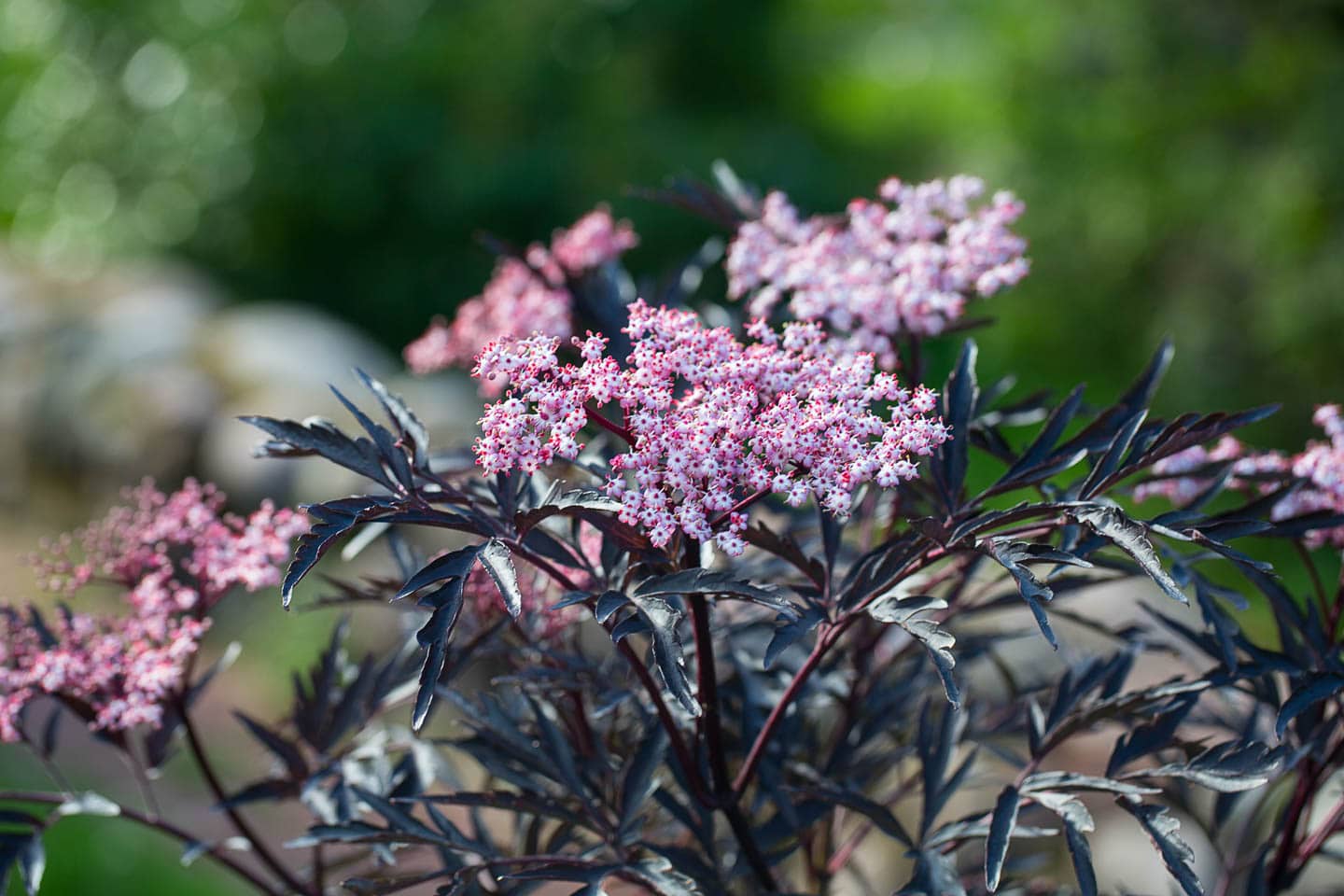
Zone: 4 – 7
Height: 6′ – 8′
Exposure: Sun to part shade
Bloom time: Early to mid summer
Bloom color: Pale pink
The elderberry bush has long been associated with cottage gardens.
The ‘black lace’ variety has unique purple/black, deeply cut, lacy leaves that contrast beautifully with the light pink, flower clusters.
This bush makes a wonderful foil next to chartreuse and green foliage.
The berries are edible and very high in Vitamin C, and can be used to make pastries, jam, juice and wine.
Tips for growing elderberry
- Plant ‘black lace’ in slightly acidic soil that is well drained.
- Elderberry can tolerate more moisture than most shrubs because the wild variety grows near bogs.
- It is best planted in the spring and should be well mulched to retain soil moisture and to give winter protection to its shallow root system.
- Prune for shape and size in the spring, and remove old branches completely.
- Black lace may be cut to the ground annually and grown as a perennial.
- It blooms on new growth.
- Cut out any suckers as they develop.
- This tough plant is deer resistant.
- To produce berries, the plant needs another variety nearby as a pollinator.
9 | Spirea (Spiraea)
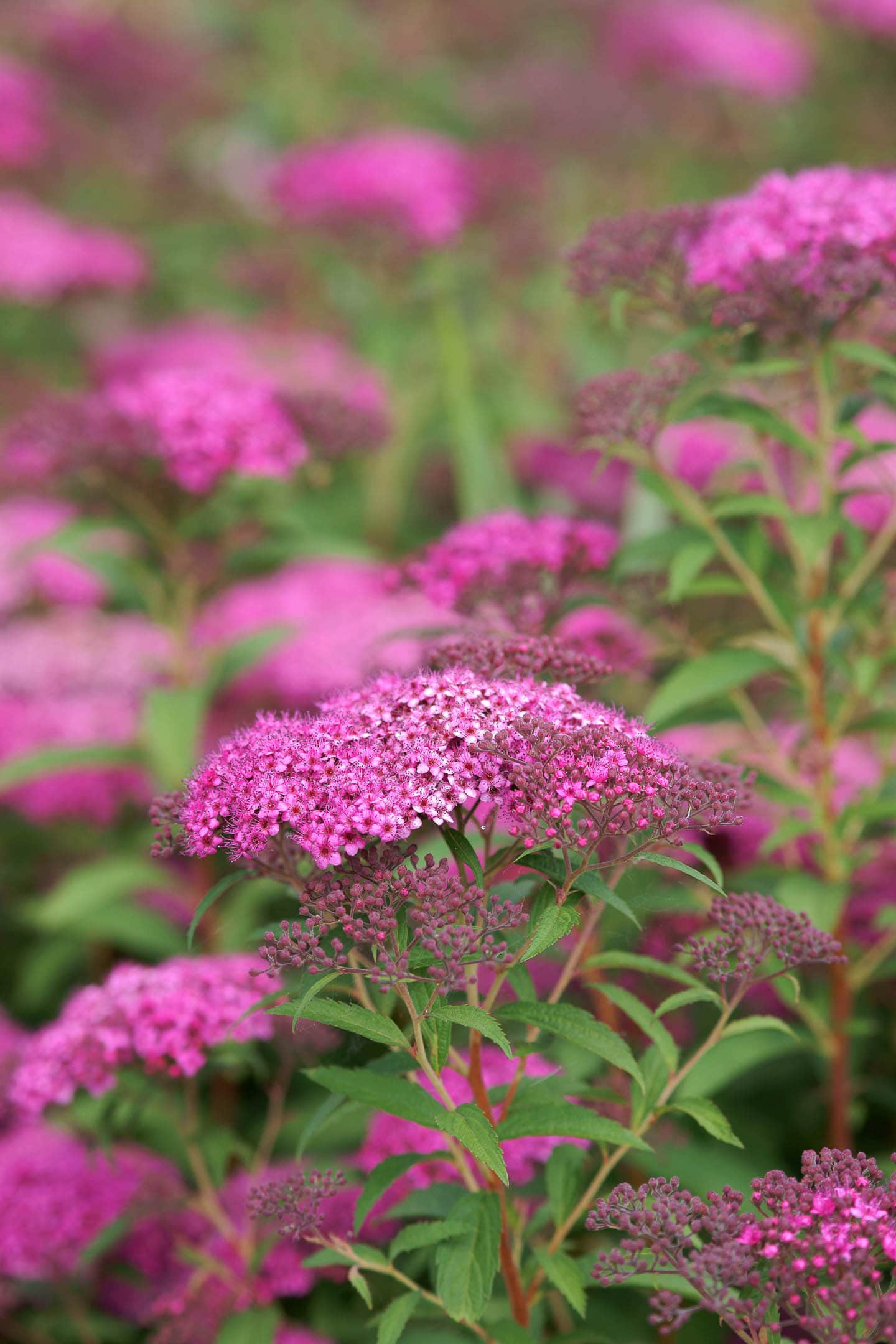
Zone: 5 – 9
Height: 1′ – 3′
Exposure: Full sun
Bloom time: Spring or summer (depending on the variety)
Bloom color: White, pink, red, purple
Spirea is another easy to grow, hardy bush that will add beauty to your cottage garden.
The ‘Double Play Doozie’ series from Proven Winners is my first choice of varieties. They are compact plants that do not need pruning, have interesting foliage with fall color, and bloom from spring though summer and fall. And because the plants are sterile, they cannot spread willy-nilly.
If your garden has a yellow theme, you should consider planting ‘Double Play Candy Corn,’ for its yellow/orange foliage and dark purple flowers.
I have ‘Anthony Waterer’ spirea in my garden that blooms deep pink clusters in the summer. Then the foliage turns yellow-orange in the fall.
Tips for growing spirea
- Spirea grows in neutral, well-drained soil and needs little care.
- If you must prune, do it after blooming on the spring bloomers, and in the late fall on the summer bloomers.
- The blooms attract bees and butterflies and the bush is deer resistant.
- Some varieties are invasive in some areas, so be cautious and research before you buy.
Other garden ideas you might like
- How to design a modern cottage garden
- The best perennials for a cottage garden
- Full sun perennials for a cutting garden
Or browse all of our shrubs posts.
Have comments or questions on the best shrubs for a cottage garden? Tell us in the section below.
This post was originally published on June 8, 2022 but was updated with new content on April 12, 2024.





